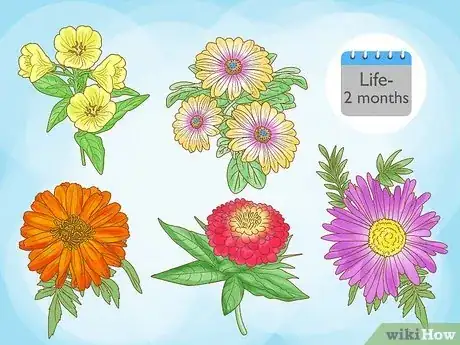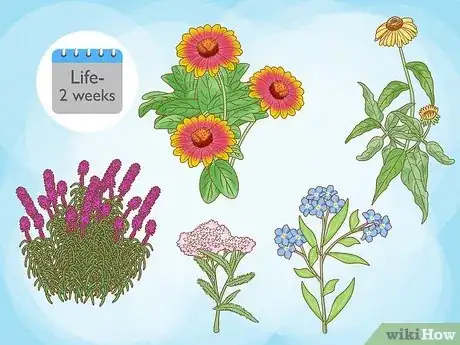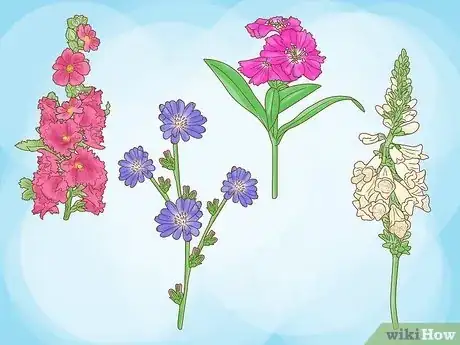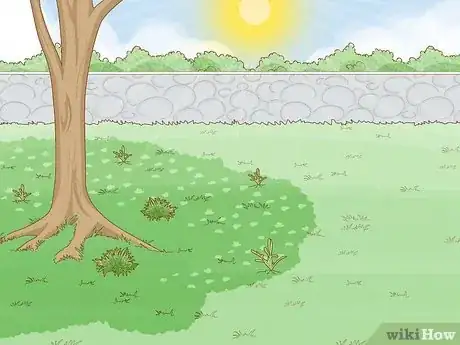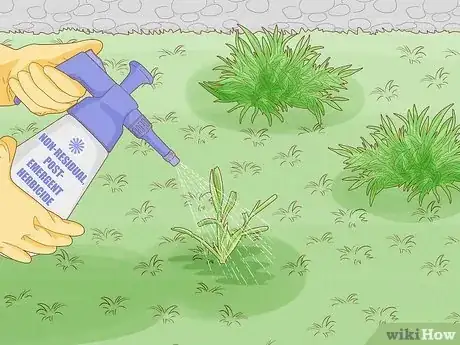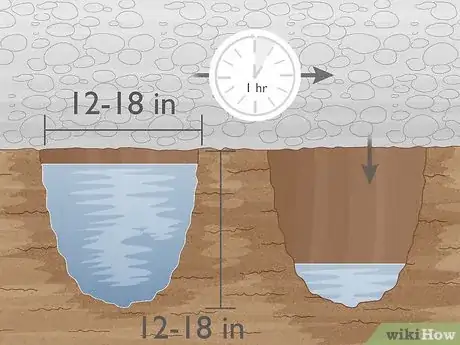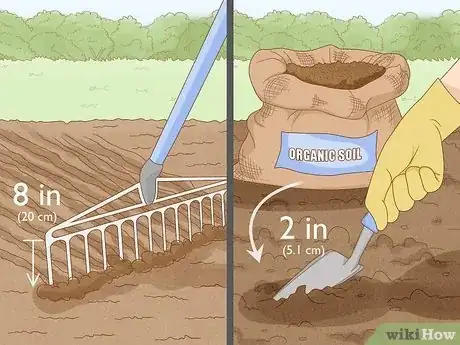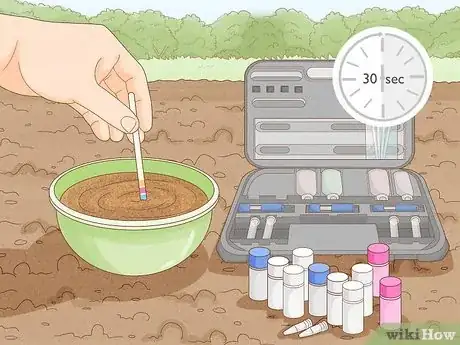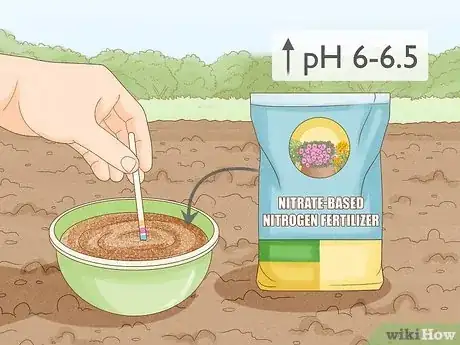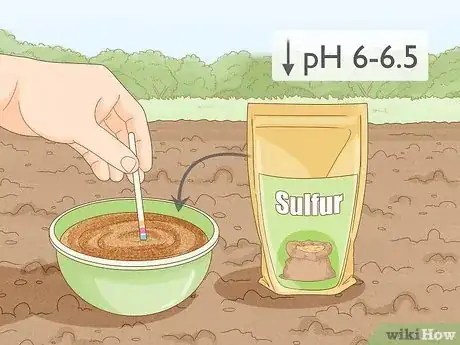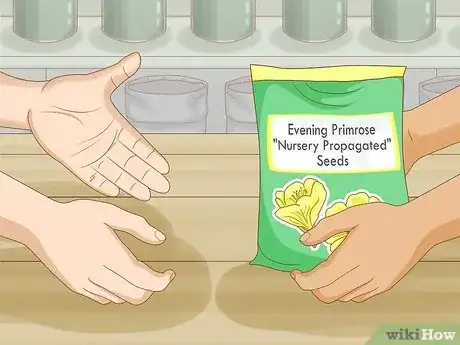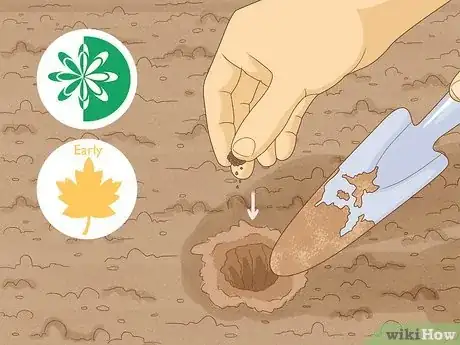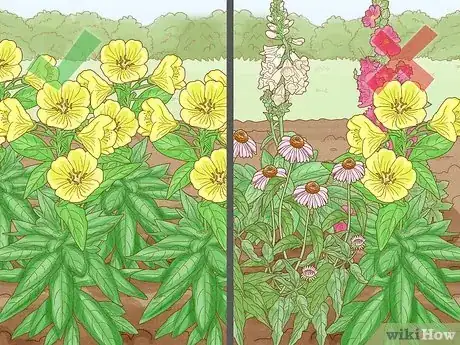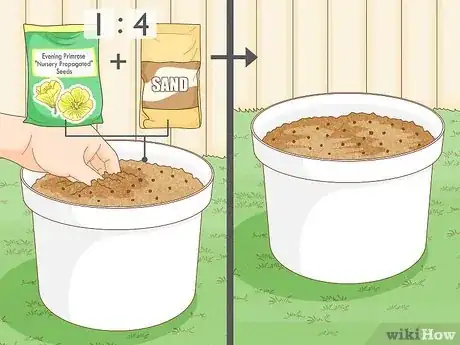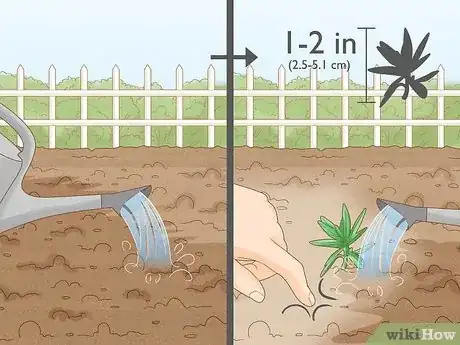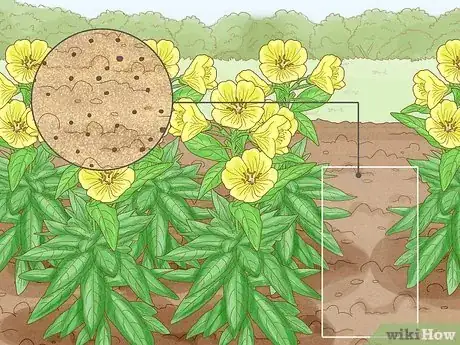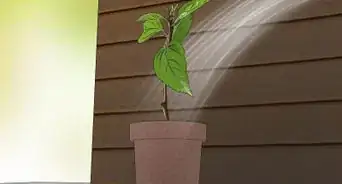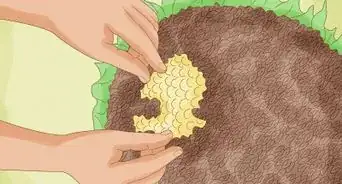This article was co-authored by Sina Kamran. Sina Kamran is a Hardscaping Specialist and the Owner of Design Scapes, Inc. in Santa Monica, California. With over 15 years of experience, he specializes in customized, site-specific hardscaping and landscaping design/build projects. He's a certified National Concrete Masonry Association (NCMA) designer, a certified installer with the Interlocking Concrete Pavement Institute (ICPI), and a Rain Bird Certified Irrigation Professional. Additionally, Design Scapes, Inc. has many 5-star rated reviews.
There are 8 references cited in this article, which can be found at the bottom of the page.
wikiHow marks an article as reader-approved once it receives enough positive feedback. This article received 24 testimonials and 100% of readers who voted found it helpful, earning it our reader-approved status.
This article has been viewed 264,838 times.
Wildflowers are easy to grow and care for, making them a great option for your garden. There are an assortment of beautiful wildflowers with different blooming patterns that you can combine to make a vibrant yard. Try planting a mixture of annual, biennial, and perennial wildflowers so that you have some plants that bloom right away, and others that emerge slowly but surely in later seasons.
Steps
Choosing Your Wildflowers
-
1Plant annual wildflowers if you want fast-blooming plants. Annual wildflowers grow and bloom 2-3 months after their seeds are planted, but usually die after 1 season. These flowers bloom for about 2 months before dying with the first frost. Choose from popular options like:
- Zinnias, which have bright pink daisy-like blooms
- Orange cosmos, flowers with vibrant orange petals and yellow centers
- Prairie asters, small flowers with delicate purple petals
- Evening primroses, which have small, cup-shaped blooms that are usually yellow or pink
- African daisies, which may have orange, pink, purple, red, white, or yellow petals
-
2Grow perennial wildflowers for slower-blooming, but long-lasting plants. Perennial wildflowers will not bloom until a full season after they are planted, but they can last for decades. Perennials only bloom for about 2 weeks a year, but their roots are winter-hardy and produce growth annually. Plant interesting perennial wildflowers like:
- Blanket flowers, which are similar to sunflowers with red and yellow petals
- Blazing star flowers, which have unique, long purple blooms
- Forget-me-nots, small flowers with rounded blue petals
- Wild yarrow flowers, which have clusters of tiny white blooms
- Coneflowers with their yellow or blue blooms (These are also known as echinacea.)
Advertisement -
3Cultivate biennial wildflowers if you want plants with a 2 year life-cycle. Biennial wildflowers bloom in their second season like perennials, but the flowers die with the first frost the way that annual wildflowers do. Biennial wildflowers seed heavily so there is a good chance of their successors lasting as long as perennials. Plant beautiful biennial choices like:
- Foxgloves, flowers with tall stems and purple, bell-shaped blooms
- Chicory flowers, delicate blue flowers in the dandelion family
- Sweet William flowers, which have white blooms with fuschia-colored centers
- Hollyhocks, flowers that bloom on tall stems in a variety of colors
Preparing the Soil
-
1Choose a spot that gets full sun or partial shade. Wildflowers require sunlight to grow. Unlike other plants, they can thrive in soil that is partially dry and rarely suffer from heat damage. Choose a spot to plant them that gets full exposure to the sun, or at most partial shade.[1]
- Baby blue eyes, wildflowers that are sensitive to heat, are a rare exception to this rule and require partial to full shade.
-
2Apply a non-residual, post-emergent herbicide to remove existing weeds. Target the weeds that have already grown in the soil by applying a herbicide designed to kill existing weeds. Choose a brand that is non-residual, meaning it will be deactivated in the soil a few days after it is used. Spray the herbicide evenly over weeds to avoid killing any other nearby plants or grasses that you want to keep.[2]
- Pre-emergent herbicide, on the other hand, is used to treat the soil before weeds emerge to prevent their seeds from growing.
- Remove existing weeds by manually pulling them out with your hand.
-
3Test your soil to see if it drains well. Most species of wildflowers thrive in well-drained soil. Determine how well-drained your soil is by digging a hole that is 12–18 inches (30–46 cm) wide and 12–18 inches (30–46 cm) deep. Fill the hole with water. If it takes more than an hour for the water to drain, you have poorly drained soil.[3]
-
4Aerate the soil if it is poorly drained by adding an organic soil amendment. Till the top 8 inches (20 cm) of the soil with a rake or shovel to break it up. Add a 2 inches (5.1 cm) layer of organic soil amendment such as sand, vermiculite, perlite, or compost on top of the soil. Work it into the soil evenly.
- The organic soil amendment should make up 25-50% of the total volume of the soil. Less than 25% will not aerate the soil properly and more than 50% may deter plant growth.
- Purchase organic soil amendment materials at a local garden center or hardware store.
-
5Test the PH level of your soil. Purchase a PH test kit from a garden center or online to measure the acidity and the alkalinity of the soil. Scoop up a small amount of soil from the surface of your garden and sprinkle it onto the mixing card from your kit. Add a few drops of indicator dye and dust the soil with the white powder in the kit. Wait for the color to change for your results[4]
- The color change should take about 30 seconds.
- Use the color chart provided in the kit to find the PH level of your soil.
-
6Use a nitrogen fertilizer to raise the soil PH level to 6-6.5. If your soil's PH level is too low, apply a nitrate-based nitrogen fertilizer to treat it. Purchase the fertilizer at a garden center, hardware store, or online. Till the fertilizer into the soil with a gardening rake or shovel.
-
7Apply elemental sulfur to lower the PH level of the soil to 6-6.5. Soil with a high PH level requires more acidity. Purchase elemental sulfur from a garden center, hardware store, or online and till it into the soil as directed. Do this at least 2 months before planting your seeds as the sulfur needs time to take effect.[5]
Planting the Seeds
-
1Buy “nursery propagated” seeds from a local nursery. Shop at local nurseries for wildflower seeds to ensure that you get species that will grow well in your climate zone. Ask for seeds that are "nursery propagated" instead of "nursery grown." This will ensure that the seeds were derived from local plant populations.[6]
- If you are buying seeds in the U.S., find native plant nurseries by visiting the Wildflower Center's suppliers directory at https://www.wildflower.org/suppliers/.
-
2Plant seeds in the spring or early autumn. Species of wildflowers that are not winter-hardy should be planted between March and May so they have time to germinate before the summer comes. Species that do better in cooler temperatures should be planted between September and November, or in autumn before the first frost. Seeds that are planted after November will usually lie dormant until the following spring.
- Only species that are very resistant to hot weather should be planted in the summer as the heat will prevent seed germination for some wildflowers.
-
3Plant one species of wildflowers at a time. The seeds for different species of wildflowers vary in weight and size, which can make them difficult to spread evenly if grouped together. Offset this problem by planting the seeds for each species one at a time. Apply them all uniformly over the same space to create a mix of flowers, or plant them in their own spots for varied looks across your garden.[7]
-
4Hand-broadcast a mix of sand and seeds over the soil. It can be difficult to distribute wildflowers seeds evenly when planting them. To do this, mix 1 part wildflower seeds in a container with 4 parts sand and shake them to mix them up. This will prevent the seeds from clumping together and growing in uneven patches.[8]
- Rake seeds into the top layer of the soil to encourage germination.
-
5Water the ground lightly for 4-6 weeks after planting to keep it moist. Water the ground as needed to keep it moist while the seeds germinate. On average this should be every 2-3 days, or more or less depending on the weather. Do not over-water the ground, which will block the flow of oxygen to the developing root systems.[9]
- Once your seedlings are 1–2 inches (2.5–5.1 cm) tall, slowly stop watering them and only provide water in very dry conditions.
- Fully-grown wildflowers do not need much water or care to grow and thrive.
-
6Spot-plant seeds each season to fill in bare spots in your garden. After 1-2 years, you will be able to see a clear growth pattern for your wildflowers. In the spring, take note of gaps between your wildflowers and plant seeds in these spaces by hand. Water the ground thoroughly and wait for new plants to sprout.[10]
- Repeat this process each spring as needed.
- Bare spots may be caused by uneven seed distribution or annual flowers that did not reseed.
Expert Q&A
-
QuestionCan you put wildflower seeds on a lawn?
 Maggie MoranMaggie Moran is a Professional Gardener in Pennsylvania.
Maggie MoranMaggie Moran is a Professional Gardener in Pennsylvania.
Home & Garden Specialist The best way to do this is to scratch up the grass to expose the soil below. This allows the seed to germinate in the soil.
The best way to do this is to scratch up the grass to expose the soil below. This allows the seed to germinate in the soil. -
QuestionWhat month should I plant wildflowers?
 Maggie MoranMaggie Moran is a Professional Gardener in Pennsylvania.
Maggie MoranMaggie Moran is a Professional Gardener in Pennsylvania.
Home & Garden Specialist The ideal time to plant wildflowers is in spring or during the early autumn months.
The ideal time to plant wildflowers is in spring or during the early autumn months. -
QuestionDo wildflowers need a lot of sun?
 Maggie MoranMaggie Moran is a Professional Gardener in Pennsylvania.
Maggie MoranMaggie Moran is a Professional Gardener in Pennsylvania.
Home & Garden Specialist Yes. Wildflowers normally bloom the best when planted in full sun or in partial shade.
Yes. Wildflowers normally bloom the best when planted in full sun or in partial shade.
Things You'll Need
Preparing the Soil
- Non-residual, post-emergent herbicide
- Organic soil amendment
- Garden rake or small shovel
Planting the Seeds
- "Nursery propagated" seeds
- Sand
- Garden rake
- Watering can or hose
Expert Interview

Thanks for reading our article! If you'd like to learn more about gardening, check out our in-depth interview with Sina Kamran.
References
- ↑ https://www.txdot.gov/inside-txdot/division/maintenance/wildflower-program/planting-wildflowers.html
- ↑ https://www.wildflower.org/learn/plant-wildflower-meadow
- ↑ https://www.bhg.com/gardening/yard/soil/what-is-well-drained-soil/
- ↑ https://www.milkwood.net/2014/03/17/how-to-test-your-garden-soils-ph-and-balance-it-for-a-better-veggie-harvest/
- ↑ https://www.planetnatural.com/organic-gardening-guru/soil/
- ↑ https://www.almanac.com/content/growing-wildflowers-list-native-plants
- ↑ https://www.wildflower.org/learn/plant-wildflower-meadow
- ↑ https://www.wildflower.org/learn/plant-wildflower-meadow
- ↑ https://aggie-horticulture.tamu.edu/wildseed/growing/watering.html
About This Article
To plant wildflowers, wait until the spring for varieties that aren't winter-hardy or the fall for varieties that do well in cooler temperatures. When you're ready to plant your wildflower seeds, choose an outdoor spot with well-draining soil that gets full sun or a little bit of shade. Then, mix 1 part wildflower seeds with 4 parts sand and sprinkle them over the soil, raking them into the top layer of the soil so they germinate. Finally, water the ground lightly every 2-3 days for 4-6 weeks so the soil stays moist. To learn how to choose the best wildflowers to plant, keep reading!
